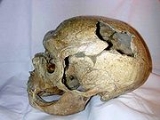
La Chapelle-aux-Saints 1
Encyclopedia
La Chapelle-aux-Saints 1 (also known as 'The Old Man') is a partial skeleton of the species Homo neanderthalensis. It was discovered in La Chapelle-aux-Saints
, France
by A. and J. Bouyssonie, and L. Bardon in 1908. The remains were first studied by Marcellin Boule, whose reconstruction of Neanderthal anatomy based on la Chapelle-aux-Saints material shaped popular perceptions of the Neanderthals for over thirty years. The La Chapelle-aux-Saints specimen is typical of 'classic' Western European Neanderthal anatomy. It is estimated to be about 60,000 years old.
 Boule's 1911 reconstruction of La Chapelle-aux-Saints 1 depicted Neanderthals with a thrust-forward skull, a spine without curvature, bent hips and knees and a divergent big toe. This depiction fit in well with contemporary evolutionary scenarios in which Neanderthals were not considered to be direct ancestors of modern humans (the relationship of Neanderthals to modern humans remains a major debate in anthropology today). In 1957, the remains were reexamined by Straus and Cave. These researchers depicted Neanderthal anatomy as being much more modern; in particular, their posture and gait was more or less identical to that of modern humans. Straus and Cave attributed Boule's errors to the severe osteoarthritis in the La Chapelle-aux-Saints Neanderthal, although physical anthropologist Erik Trinkaus has suggested that Boule's errors were primarily related to the fragmentary nature of the remains.
Boule's 1911 reconstruction of La Chapelle-aux-Saints 1 depicted Neanderthals with a thrust-forward skull, a spine without curvature, bent hips and knees and a divergent big toe. This depiction fit in well with contemporary evolutionary scenarios in which Neanderthals were not considered to be direct ancestors of modern humans (the relationship of Neanderthals to modern humans remains a major debate in anthropology today). In 1957, the remains were reexamined by Straus and Cave. These researchers depicted Neanderthal anatomy as being much more modern; in particular, their posture and gait was more or less identical to that of modern humans. Straus and Cave attributed Boule's errors to the severe osteoarthritis in the La Chapelle-aux-Saints Neanderthal, although physical anthropologist Erik Trinkaus has suggested that Boule's errors were primarily related to the fragmentary nature of the remains.
This specimen had lost many of his teeth, with evidence of healing. All of the mandibular molars were absent and consequently, some researchers suggested that the 'Old Man' would have needed someone to process his food for him. This was widely cited as an example of Neanderthal altruism, similar to Shanidar 1. However, later studies have shown that La Chapelle-aux-Saints 1 had a number of incisors, canines and premolars in place and therefore would have been able to chew his own food, although perhaps with some difficulty.
La Chapelle-aux-Saints
La Chapelle-aux-Saints is a commune in the Corrèze department in central France.-First discovery of a Neanderthal tomb:The La Chapelle-aux-Saints cave, bordering the Sourdoire valley, revealed many archeological artifacts belonging to the late Mousterian culture, including the first ever...
, France
France
The French Republic , The French Republic , The French Republic , (commonly known as France , is a unitary semi-presidential republic in Western Europe with several overseas territories and islands located on other continents and in the Indian, Pacific, and Atlantic oceans. Metropolitan France...
by A. and J. Bouyssonie, and L. Bardon in 1908. The remains were first studied by Marcellin Boule, whose reconstruction of Neanderthal anatomy based on la Chapelle-aux-Saints material shaped popular perceptions of the Neanderthals for over thirty years. The La Chapelle-aux-Saints specimen is typical of 'classic' Western European Neanderthal anatomy. It is estimated to be about 60,000 years old.

This specimen had lost many of his teeth, with evidence of healing. All of the mandibular molars were absent and consequently, some researchers suggested that the 'Old Man' would have needed someone to process his food for him. This was widely cited as an example of Neanderthal altruism, similar to Shanidar 1. However, later studies have shown that La Chapelle-aux-Saints 1 had a number of incisors, canines and premolars in place and therefore would have been able to chew his own food, although perhaps with some difficulty.
See also
- List of fossil sites (with link directory)
- List of hominina (hominid) fossils (with images)

